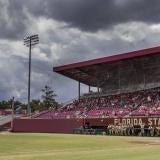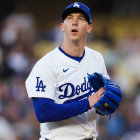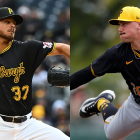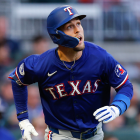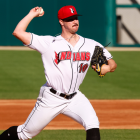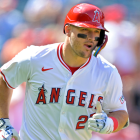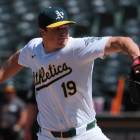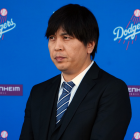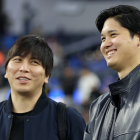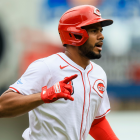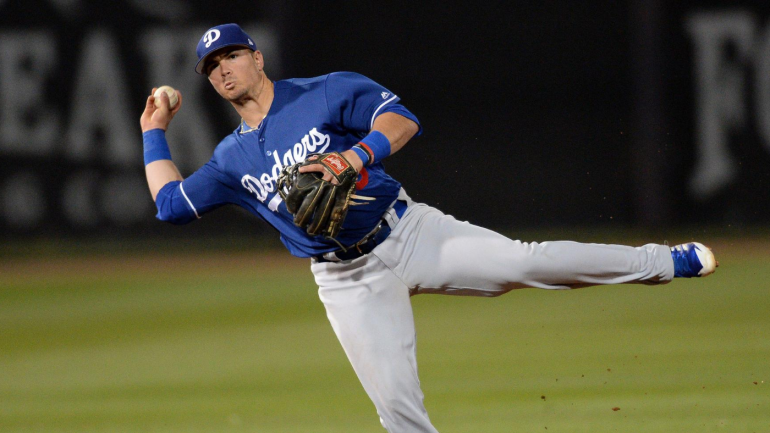
Major League Baseball's trade deadline, scheduled for Aug. 31 at 4 p.m. ET, is now just a week away. While this deadline is unlikely to be as active as usual for a variety of reasons -- including the financial uncertainty stemming from the pandemic, and the lack of separation between the contenders and pretenders caused by the expanded postseason and shortened regular season -- there are still likely to be trades, albeit of the lower-stakes variety.
Last week, we highlighted the 25 big-league players who we believe could be on the move at the deadline. Today, we're going to flip the script and examine which prospects could be dealt.
Before we dive in, let us explain our process for determining these names.
Essentially, we focused on non-elite prospects and youngsters included in 18 potential buyers' player pools who are either blocked; are eligible for the Rule 5 draft; or are out of options, according to FanGraphs. Each player's reason for inclusion will be noted in parentheticals after their initial mention. To be clear: we're not saying these players will be left unprotected; we're just acknowledging the truth, which is that teams often look to move players who require protection, and who they might not be sold on.
Of course, it's wholly possible that MLB alters the roster rules a little over the coming months in response to the pandemic. Some sources have speculated to CBS Sports that this winter might not feature a Rule 5 draft because of the lack of a legitimate minor-league season. We know that, we get that, we're just trying to provide a service by highlighting potential trade candidates.
With those caveats in mind, let's get to the business of conjecture.
Arizona Diamondbacks
The Diamondbacks selected first baseman Pavin Smith (Rule 5) seventh overall in the 2017 draft, ahead of Keston Hiura and Jo Adell, among others. He was and he remains a contact-over-power bat who tends to walk as frequently as he strikes out. Smith's stock improved a touch last season because of two developments: first, he lifted the ball more often; and second, he received more exposure to the corner outfield. He isn't going to mature into a slugger, or even a good defensive outfielder, but modest, sustained improvement in those areas should be enough for him to become a tolerable platoon option against right-handed pitchers.
Right-hander J.B. Bukauskas (Rule 5), who came over in last summer's Zack Greinke trade, was also selected in the first round in 2017, albeit at pick No. 15 and by the Astros. He's short and wild (he's walked about five batters per nine for his career), and he comes equipped with at least two good pitches (and sometimes more) and an arm stroke that's briefer than the average Guided by Voices song. If that sounds like a reliever, well, he's probably heading in that direction. Because times are changing, the Diamondbacks (or some other team) could experiment with using Bukauskas in a hybrid role that would allow him to turn over a lineup once, thereby limiting the potential damage that could be incurred by his command issues.
Another right-hander, Luis Frias (Rule 5), has an edge over Bukauskas in the sense that he looks more like a starter thanks to his larger frame (he's listed at 6-foot-3, 180-plus pounds). Otherwise, Frias has a lot in common with Bukauskas: an intriguing arsenal, including a good fastball and curveball, and a delivery that has resulted in some serious command woes. He too could end up in the bullpen, depending on how he's able to progress over the coming years.
Atlanta Braves
The Braves could, in theory, move any number of young arms, either on or off their 40-player roster. For our purposes, we'll focus on just one of those possibilities: 6-foot-7 left-hander Kyle Muller (Rule 5). Muller has a high-grade fastball, and he used it to great effect in Double-A last season, resulting in 120 strikeouts in 111 frames. Alas, he also walked more than five batters per nine during that same stint. His future role hinges on the refinement of his command.
Chicago Cubs
Right-hander Adbert Alzolay (optionless) is the headliner for the Cubs. He has two high-grade pitches, in his fastball and his curveball, but needs to further refine his changeup and his command to stick as a starter. The Cubs will be sniffing around for relief help, and it's reasonable to think they might conclude Alzolay is better in that role than anyone they can get.
There are three other right-handers who merit mention here and who could factor into the Cubs' rest-of-season pitching plans: Cory Abbott (Rule 5), Keegan Thompson (Rule 5), and Dakota Mekkes (Rule 5). Abbott, the best of the three, struck out 166 batters in 146 Double-A innings last season. His raw stuff isn't as good as that statistic suggests, though he does have an above-average curveball and a physical frame. Thompson and Mekkes each could've debuted by now, as a swingman and middle reliever. Unfortunately, Thompson was limited to three regular-season starts last year because of injury, and Mekkes continued to issue too many free passes (6.20 per nine innings) for someone who does not have Dillon Maples' stuff.
Third baseman Christopher Morel (Rule 5) missed significant time last year because of a knee issue. He just turned 21 years old and he has the power potential, the arm, and the athleticism to develop into a regular. Those are reasons to buy in. The main reason not to buy in is his plate discipline, as he struck out more than five times as often as he walked in 2019.
Chicago White Sox
The White Sox inked outfielder Micker Adolfo (optionless) for $1.6 million in July 2013. In the years since, he's struggled with injuries and with making consistent contact. That combination could be seen in concert last season, when he appeared in 36 games and struck out more than 37 percent of the time. Woof. Adolfo has big-time raw power and, seemingly, little hope of ever guiding his bat to the ball frequently enough for it to matter. He'll turn 24 in September.
Jose Ruiz (optionless) and Tyler Johnson (Rule 5) could appeal to teams in reliever-for-reliever swaps. Ruiz hasn't found much success in the majors despite an upper-90s fastball with good spin. He's essentially benched his changeup, which showed promise, and taken to using a breaking ball as his off-look. It hasn't worked out. Johnson, on the other hand, hasn't reached the majors. He has an awkward-looking motion and middle-relief aspirations.
Cincinnati Reds
Outfielder Aristides Aquino (optionless) made waves late last season, when he surfaced from the Quad-A depths to homer 19 times in 56 games. Maybe it was because that felt like forever ago by the time the season began, but the Reds didn't seem inclined to take his breakout seriously: he didn't break camp with the big-league club, and he entered Saturday with nine plate appearances in five games. It's hard to blame them for their lack of faith. Aquino whiffs a lot, and, even with the home-run binge, he finished last season with a substandard exit velocity. Some team might want to see if Aquino can again catch lightning in a bottle; otherwise, most future references to him will begin with "remember" and end with a question mark.
The Reds have been more than willing to trade prospects for veterans in recent years. Outfielder Stuart Fairchild (Rule 5) would be a sensible target for a team sweeter on his chances of ending up as a regular. At worst, Fairchild would be a fine fourth outfielder. He can do a little bit of everything, including playing center, and he's shown an aptitude for improving, demonstrating as much by learning to lift and pull the ball more frequently since turning pro.
Cleveland
Bobby Bradley (blocked) might be heading down the Aquino career path. He turned 24 in late May, and is coming off a 33-homer season in Triple-A. Based on that, you might think he'd be a valued part of Cleveland's future. He's not, and it's because of how often he punches out. Bradley struck out in nearly 34 percent of his minor-league plate appearances in 2019, and he made contact on just 63 percent of his swings in a 15-game stretch against big-league pitching. Add in how Bradley doesn't provide much value defensively or on the basepaths and everything boils down to how often he can walk or run into one. Probably not often enough.
Cleveland has acquired Oscar Mercado (optionless), Jake Bauers (optionless), and Jefry Rodriguez (optionless) in trades over the last several years. Mercado is a good defensive outfielder who can pitch in on the bases. His horrid start to this season resulted in a demotion. Bauers improved his launch angle and his exit velocity in his first season with Cleveland. He's young, but Cleveland might wish they would've found a way to keep Yandy Diaz around when all is said and done. Rodriguez hasn't given reason to believe he's going to make it as a starter.
Let's briefly touch on three Rule 5-eligible players: infielder Ernie Clement can put the bat on the ball and run, and he could have a career as a bench piece; right-hander Eli Morgan just keeps getting outs despite an arsenal that boasts one above-average pitch: a very good changeup; and then there's southpaw Kyle Nelson, who is almost ready for big-league relief work.
Colorado Rockies
Yonathan Daza (optionless) is, like a few others included on this list, a readymade reserve outfielder thanks to his glove and his wheels. He's a contact-orientated hitter who doesn't walk often, and who required both the PCL and a juiced ball to hit double-digit home runs.
Elsewhere, the Rockies have a few Rule 5 types to consider, in left-hander Helcris Olivarez and righty Tommy Doyle. Olivarez has a pretty delivery and a starter's frame. He's yet to pitch above Rookie ball. Doyle is a fastball-slider reliever who would've spent this year in Double-A.
Houston Astros
Houston has leveraged a fair amount of its prospect depth just to field a pitching staff. The Astros do have two outfield prospects with Triple-A experience who check our boxes, in Chas McCormick (Rule 5) and Ronnie Dawson (Rule 5). McCormick has done a better job of lifting the ball, and has done so while maintaining a scratch or better walk-to-strikeout ratio. Dawson has a slightly more dynamic skill set, though he's also more prone to striking out. They could each become reserve outfielders, but it seems more likely that they both fall short. It happens.
Los Angeles Dodgers
The Dodgers have about as many Rule 5-eligible types as any contender. They also have one of the deepest and most complete rosters in the league, suggesting something has to give.
We'll start on the hitting side with Cuban infielder Omar Estevez, who the Dodgers signed when they inked (now-Orioles) outfielder Yusniel Diaz. He reached Double-A last season and hit .291/.352/.431, which is a good sign for someone whose bat will determine if he can fill a bench role. Outfielder Zach Reks will turn 27 in November. He's probably never going to get a look with the Dodgers, so his best bet at a big-league career is that another team is taken by his above-average raw power and on-base skills. Fellow outfielder Cody Thomas is young and more athletic than Reks. There's some belief in the league that he could be a late-bloomer type.
As for the pitchers, Andre Jackson is a long-term play who could turn into a back-end starter. Little cannon Gerardo Carrillo was already being requested in trades last year. Edwin Uceta has a good changeup and a delivery that bodes well for his command and his deception. He could wind up in the bullpen, where he would join, among others, righty reliever Marshall Kasowski (who has a vertical release point and good stuff, as well as command woes) and Brett de Geus (who has less raw stuff and more command than Kasowski).
Milwaukee Brewers
The Brewers do not have a good farm system. Keep that in mind, because we're going to keep things brief here.
Catcher Payton Henry (Rule 5), the only hitter in this group, has a good defensive reputation and above-average strength. He also swings and misses often, and he hasn't yet passed the page-69 test that is Double-A. Calling him a future backup catcher seems reasonable.
Elsewhere, the Brewers have three pitchers who could be of interest to sellers: Zack Brown (Rule 5), Alec Bettinger (Rule 5), and Phil Bickford (Rule 5). Brown was scorched in Triple-A last season, to the extent that he went from one of Milwaukee's top prospects to being unpicked in the Rule 5 draft. Bettinger pitched well in Double-A despite a so-so arsenal that hints at him being tapped out as a back-end starter. Bickford also went unpicked in last winter's Rule 5 draft, presumably because of enduring makeup concerns.
Minnesota Twins
Brent Rooker (Rule 5, blocked) likely would've debuted in the majors last summer had his injury-caused absence not coincided with Nelson Cruz's. You hope it doesn't become a "what if?" moment for Rooker, who will turn 26 in November with a skill set more befitting of a 36-year-old. He hit .281/.398/.535 in Triple-A last season, and did so while striking out nearly 35 percent of the time. Some team is eventually going to give him a few hundred plate appearances, either as a first baseman or as DH, to see if he can make enough contact to stick.
Edwar Colina (Rule 5) is a short, stocky right-hander with an above-average fastball-slider combination. He's been a starter for most of his professional career, but his future is likely in relief, perhaps in a hybrid role where he can turn over an order once before being overexposed. The Twins have become pretty good at pitching development, so their excess is still rosterable.
On that note, you could probably throw Australian lefty Lewis Thorpe (optionless) in here, too. His velocity was down in his big-league appearances this season, but it only takes one team to believe he can still cut it as a back-end starter for a deal to materialize.
New York Yankees
Albert Abreu (optionless) originally joined the Yankees as part of the November 2016 trade that sent catcher Brian McCann to the Astros. He made his long-awaited big-league debut earlier this season, striking out or walking four of the 10 batters he faced. There's no doubting Abreu's stuff, as he throws hard and has a pair of promising secondaries; there is doubting his consistency and his command, a combination that will likely sentence him to a career in relief. The Yankees have been trying to extract more from Abreu for years now. It's time, or close to it, for someone else to give a go.
Alexander Vizcaino (Rule 5) can touch the upper-90s and complements his fire with a hard changeup. He has to keep nursing his slider if he's going to remain in the rotation. Twenty years ago, you'd say that was an unlikely possibility and move on; these days it's still not a given, but you have to be cognizant of how the Pitch Design Era has changed development arcs.
Oakland Athletics
Various injuries to various body parts have prevented Greg Deichmann (Rule 5) from playing in more than 100 games in a season since he was drafted in the second round in 2017. He was healthy during his stint in last year's Arizona Fall League, where he launched nine home runs in 23 games in an impressive display of his raw power. Deichmann also showcased the blowback from his long swing by striking out in more than 30 percent of his plate appearances during those games. It's only fair to be concerned about his durability, his swing-and-miss tendencies, and his age (he turned 25 in May). Still, he could be a cheap platoon bat for someone soon.
David Forst and company have some other flawed outfielders to offer if Deichmann is considered off limits. Dustin Fowler (optionless) came over as part of the Sonny Gray deal. He shredded his knee in his debut, but returned last season to hit .277/.333/.477. Fowler didn't get a call to the majors because his marks look significantly less impressive when it's noted that the A's Triple-A squad hit .298/.371/.531 as a team. Buddy Reed (Rule 5) was part of the latest Jurickson Profar swap. He can run and he can field, but he's yet to solve Double-A pitching.
Let's keep the tandem paragraphs going by highlighting some pitcher combinations.
Right-handers Parker Dunshee (Rule 5) and Brian Howard (Rule 5) could each become back-end starters thanks more to deception than stuff. Dunshee is short with an abbreviated arm stroke, while Howard is tall with a steep release point. The two combined for 24 Triple-A appearances last season, and they averaged more than two home runs allowed per nine innings. That kind of gopheritis wasn't prevalent in either of their games prior to 2019, so we're going to chalk that up to the hitting environment and the juiced ball over their deficiencies.
Sellers seeking boom-or-bust relievers could also bug Oakland about Miguel Romero (Rule 5) or Wandisson Charles (Rule 5). Both have big-league arsenals and minor-league command.
Philadelphia Phillies
The Phillies went ahead and traded Nick Pivetta to Boston before we could include him in this piece. Rude. That leaves lefty Damon Jones (Rule 5) as their lone qualifier. He improved his stock last season with a better slider and by having success against more age-appropriate competition. Jones will turn 26 in September and his command hints at a future in relief. The Phillies might opt to plug him into their bullpen rather than use him as bait to land an established arm.
San Diego Padres
A.J. Preller has never been shy about making trades. Presuming Preller stays true to himself, he'll probably be dealing from a group that's larger than what we have here. Tucupita Marcano (Rule 5) is something like the fifth shortstop on the Padres' depth chart. He's on the smaller side, and he's unlikely to ever hit for power. He makes a ton of contact, however, and could develop into a utility type. The Padres received corner infielder Jason Vosler (Rule 5) from the Cubs as the return on Rowan Wick. He walks and has above-average pop. He's on the older side (27 in September), though, and his upside is turning into a professional pinch-hitter.
St. Louis Cardinals
The Cardinals acquired outfielder Justin Williams (optionless) from the Rays two deadlines ago as part of the return on Tommy Pham. He took his only big-league plate appearance before the trade, a stat he owes to an injury-filled 2019, but it happened to have an illustrative result. Williams hit the ball hard (90 mph exit velocity), and he hit it right into the ground. That's his deal; he's big and strong, and he can punish a ball … just, generally, not at the optimal angle. He doesn't offer much in terms of secondary skills, so he'll have to replicate the model established by the likes of Avisail Garcia and Yandy Diaz in order to become a regular.
Tampa Bay Rays
First baseman Nate Lowe (blocked) hit .263/.325/.454 in the 50 games last season that served as his big-league introduction. It wasn't enough; not to elevate him over Ji-Man Choi, and not to convince the Rays that Yoshi Tsutsugo was an unnecessary addition. Lowe has the means, with his plate discipline and his raw strength, to be someone's first baseman or DH. What he doesn't have is an opportunity, or a ton of time left to wait for one. He turned 25 in July, and it tends to get late early for players reliant upon old-player skills. The Rays need to find a spot for him, in their lineup or in a trade, before they risk wasting his time and his value for no gosh darn reason.
Infielder Taylor Walls (blocked, Rule 5) is behind too many superior prospects to see him receiving much burn with the Rays. He can hit, he can run, and he can defend the shortstop position. His ability to work the stick and the count against big-league pitchers, who might feel empowered by his lack of pop, will determine where he falls on the starter-reserve spectrum. Walls should take solace in the trades (and successes) of Nick Solak and Jake Cronenworth.
Washington Nationals
The Nationals' lackluster farm system means they're likely to keep and protect anyone of note. For the sake of including the defending champions, we'll point out that 21-year-old right-hander Joan Adon (Rule 5) transitioned to starting last season and fared well against more senior competition. He doesn't have top-flight stuff or command, and he doesn't appear to have much physical projection remaining. If Adon is going to pitch in the majors, it's likely to be in relief. Maybe some team feels differently and will spare a veteran rental to bring him in.







